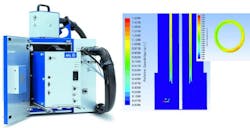Reducing atmospheric particulate matter, including the nanoparticles emitted from internal-combustion engines, helps human health. A team of Austrian researchers from CTR Carinthian Tech Research (Villach) and AVL List (Graz) has developed a high-precision scattering-based optical sensor that can detect particles with a diameter of less than 0.2 µm. The size is particularly important, because the smaller the particles are, the more harmful they are to health.
A tailored, simulation-aided design process has enabled the particle counter to accurately detect the smallest of pollutants and measure them at three times the speed. At the same time, the researchers improved the system's overall stability and control. The improvements have been applied to AVL's APCplus exhaust-analysis product range, which has been on the market since autumn 2016. The device is used in automotive development, monitoring, and exhaust gas analysis.
Integrative system modeling and codesign
Nanoparticles below 200 nm are in a size range that is exceptionally difficult to measure. Detecting the actual particulate emissions involves counting the nanoparticles in the air or exhaust gas individually and not as total parameters. To do so, the nanoparticles are fed into a supersaturated atmosphere. In it, they act as condensation nuclei and create an aerosol stream in which the droplets can be counted individually. This requires the interaction between the thermal, physical, and chemical processes to be carefully managed to ensure reliable particle detection.
"We created a comprehensive 3D simulation model on the computer and compared it with experimental data," says Martin Kraft, CTR's head of research in photonic-systems engineering. "The challenge lay in the complexity of the measurement principle and mutual dependencies. Only when you research and develop extensively and systematically can the overall system be improved."
"The nanoparticle sensor's power has increased by 20%," says Tristan Reinisch, Product Development Team Leader at AVL. "We thus achieve a high level of selectivity with reference to the nanoparticle diameter and obtain faster count results."
Strategic research partnership
Research cooperation between AVL and CTR is planned in the long term. Initial basic research began with the first phase (2008-2014) of the COMET center-of-excellence program and is continuing under the current program (2015-2022) dedicated to ASSIC (Austrian Smart Systems Integration Research Center).
CTR is the largest nonacademic research centre in Carinthia and ranks among Austria's leading research institutes in the area of smart sensors and systems integration. Its task and objective is to develop innovative sensor technologies (photonic, sensor, micro- and nanosystems, and assembly, packaging, and integration technologies) for industry and to integrate them in concrete applications. Services range from feasibility studies, simulations and tests to prototyping and system design. Research partners include ABB, AT&S, AVL List, Infineon Technologies, Lam Research, EPCOS, Philips Austria, Siemens, TIPS Messtechnik, the European Space Agency (ESA), Vienna University of Technology, Carinthia University of Applied Sciences, Klagenfurt University, and Lausanne EPFL.
Source: goo.gl/bEAoeo

